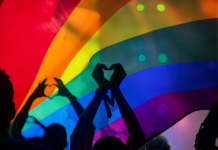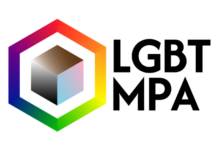 Pride month means more than just slapping rainbows on signage. “If you’re going to lean in, lean in all the way,” says event guru Edward Perotti.
Pride month means more than just slapping rainbows on signage. “If you’re going to lean in, lean in all the way,” says event guru Edward Perotti.
Those holding meetings and events during June, which is Pride Month, may be tempted to signal solidarity by hanging a few rainbow banners, but does that really make your LGTBQ+ attendees feel welcome and included? “At this point, we can all smell the surface stuff a mile away,” says award-winning event designer Edward Perotti, of EP Events & Experiences. “If you’re going to lean in, lean in 100%. Be 100% intentional about what you’re doing. Just having a logo redone as a rainbow and giving pins to everyone? Sorry, no. You want to make people feel comfortable so they can bring their best self forward. That only happens when you stop putting restraints around people.”
If your job as a meeting professional is to be a strategic thinker, and your organization is proclaiming to be rooted in diversity and inclusion, “You need to wave that flag wide and high so everyone feels empowered to stand up as their true self and use their voice,” he adds. “When people can truly be themselves, that’s what’s going to shift the needle in how employees and attendees view the organization. Events drive culture.”
Prevue recently caught up with Perotti, fresh off a speaking gig at a recent Prevue Summit, to find out more about how organizations can lean in 100% for Pride Month instead of just “queer-washing.”
Prevue: What are some of the common mistakes organizations make when trying to express support for the LGBTQ+ community at events held during Pride Month?
Perotti: You don’t want to only show that support during Pride Month, for one thing, like it only comes out like Uncle Charlie at Christmas and then it all goes back into the closet. If it’s part of your corporate values, it should be part of your event structure and marketing plan. If it’s not, don’t call attention to that fact by doing a token Band-Aid gesture. If you really care, you’ll have your female, Black lesbian speaker giving keynote addresses — and not just on DEI or HR. If you’re just doing the bare minimum to save face, I’d rather you do nothing. This goes for events held during months recognizing all the marginalized groups, not just LGBTQ+. Our events should be inclusive 365 days a year. Take a stand, either way. If the company’s culture supports efforts to be inclusive of marginalized groups, leadership has to enable the event person to lean in 100%.
Prevue: But how can an event professional lean in without seeming trite or superficial? Should they not incorporate rainbow flags and pins?
 Perotti: One idea I saw recently that was disarming in a fun, silly way was to have badge ribbons for every possible thing — they had little flags representing Black individuals, and others that representing the queer community. I’m somebody who likes to be defined by my actions, not based off a label. That being said, having a ribbon that says, “Yo Queen,” oh hell yes I would put that sucker on my badge, because it says something without saying things.
Perotti: One idea I saw recently that was disarming in a fun, silly way was to have badge ribbons for every possible thing — they had little flags representing Black individuals, and others that representing the queer community. I’m somebody who likes to be defined by my actions, not based off a label. That being said, having a ribbon that says, “Yo Queen,” oh hell yes I would put that sucker on my badge, because it says something without saying things.
How cool would it be to let people choose a color from the Pride flag that best represents you as a member or an ally of a community (and by the way, you can tell the story of the Pride rainbow flag, which many people don’t know really originated in 1978 by Gilbert Baker with eight colors after the assassination of Harvey Milk, not from the Wizard of Oz). You can put a color chart on the back of the badge for those who don’t know what each represents.
Printing the badges in different colors is not a big expensive move, but it is a fun way to lean into supporting the community during Pride Month that doesn’t affect branding or logos or anything else on the badge. And it gives people a way to connect or identify in a way that still provides a safe space for allies to come into the fold as well. Your badge says it all without labeling anyone specifically — you could be a member of that community or an ally. It gives people another connection point.
Prevue: What are some other ways meeting and event professionals can express support in ways that are more than just lip service?
Perotti: One would be to partner with vendors — food providers, florists, AV — that are LGBTQ+-owned. The bureaus know who those vendors are. Just ask them for a list of Black-owned restaurants, or female-owned florists, or LGBTQ+-owned AV companies. We always go local anyway, so why not lean in 100% for events held during months of awareness for specific marginalized communities? During peak awareness times of the year, lean in and tell the story of how you are supporting the communities where you meet.
Prevue: What if your meeting is being held during one of the peak awareness times in a destination that is thought of as politically unfriendly to that particular community?
Perotti: Marginalized communities in states that are political hotbeds are the ones that need the most support. It’s our job during these times of peak awareness to make a concerted effort to find those vendors and bring them into the light.
Prevue: You mentioned the importance of having speakers who represent the full spectrum of the audience. Why is this still such a struggle?
Perotti: Some people are afraid to put someone like me on a stage because they’re afraid of what would come out of my mouth, they’re afraid I’ll call them out. And they’re afraid I will show up as my authentic self — which means I won’t be wearing a suit and tie. That’s not my professional brand. Part of pride is taking pride in yourself. Your voice is what makes people take you seriously, not whether you show up in a cool Gucci sweater versus a suit.
Event organizers need to learn to be comfortable with people showing up as their true, authentic self, whether on the stage or off. To do otherwise is a form of psychological warfare in terms of operating events from an inclusive perspective.
Prevue: But we’re so conditioned to want to fit in, to be like everyone else at the event, to not stand out as “other.” That’s why the one thing everyone actually reads in the “know before you go” is what the dress code is.
Perotti: My husband, who is a wardrobe stylist, for years has created a lookbook for my incentive trips. It gives suggestions for each event — resort casual is different in Hawaii than Bermuda. Why don’t we do that for conferences, so when we say, “business casual,” people can see visuals of every style that would stay within the corporate guidelines. Throw in some non-binary wardrobe pieces so people know they can show up how they’re comfortable. I mean, no pajamas, and you have to be clean, but give people permission ahead of time with a visual idea so Becky doesn’t feel she has to go to Rent the Runway to put in an appearance that doesn’t go with her own professional brand.
We hire people for their talent, their ability to push business forward. It shouldn’t matter if they wear wool trousers or denim. Leaders also should show up as their authentic selves, to model that it’s OK to do that. No one should have to be afraid of their own reflection.
But for this to happen, the event professional needs to not be scared to stand up and say, with conviction, “This is good for the business.” Have the data to prove it, but don’t be afraid to stand up and use your voice. Leaders may know more than we do about some things, but we’re more expert in how people interact. In order to change a mindset, you need to get leadership out of their comfort zone a little bit. When they realize they get positive reinforcement for it, the next change becomes easier. You need to bring them along the journey instead of letting them do a surface-level Pride month.
And remember that inclusion means everyone. No one should have to hide who they are. Good is just as subjective as bad. We’re all individuals, and even with all our differences we do have connection points.
It’s so much easier and healthier to be that person, not to feel like you have to live separate lives at home and at work or an event. It’s a badge of honor to be invited to show up as your authentic self, not something that you have to hide under a lapel.
You May Also Be Interested In…
5 Ways to Celebrate Pride Month 2024
Make Your Event LGBTQ-Inclusive
Exclusive: Talking Accessibility with Cvent’s Stephen Cutchins










